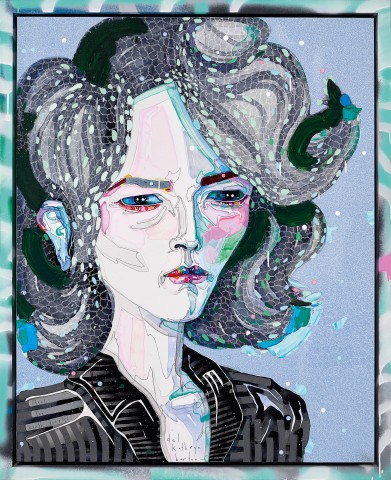FEEL THE EARTH, DEEPLY, 2019
DEL KATHRYN BARTON
oil and synthetic polymer paint on French linen in hand-painted artist’s frame
102.0 x 81.5 cm
109.5 x 89.0 cm (including artist's frame)
signed lower centre: – del / Kathryn / barton –
inscribed with title lower left: feel / the / earth, deeply
Roslyn Oxley9 Gallery, Sydney
Private collection, Sydney, acquired from the above in October 2019
Del Kathryn Barton, i wanted to build a bed for all the tired beds, Roslyn Oxley9 Gallery, Sydney, 3 – 25 October 2019, cat. 8
Featured in a recent solo exhibition – the first since her 2017 National Gallery of Victoria mid-career survey – Feel the Earth, Deeply, 2019 is one of the latest in a series of Del Kathryn Barton’s sumptuous and meticulously patterned portraits of women and chimeric goddesses. These mature and regal portraits draw their inspiration from the format of High Renaissance portraiture of the gilded elite, and often imbued with the unsettled eroticism of modern European artists, Egon Schiele and Louise Bourgeois. Included in many of her most commercially successful series, the three-quarter profile of the head and bust has been a mainstay of Barton’s practice since 2014 and has supplanted her earlier vulnerable paintings of girls – the ethereal females of this phantasmagorial universe aging alongside the artist, their creator.
Feel the Earth, Deeply features a woman, anonymous in her features save for the voluminous hair billowing in serpentine waves around her face, full of secrets. Described by the artist as ‘her companions’, the women of these serial portraits on both canvas and paper share the simple monumentality of the portraits with which Barton won the Archibald Prize on two occasions. This compositional format allows Barton to abandon herself to patterned detail and to carefully hone the emotional complexity of her sitters’ expressions. Barton’s woman is placed here within an empty and shallow pictorial space, filled only with a delicate veil of dotted patterns. Del Kathryn Barton’s profusion of patterning within the bodies and accoutrements of her figures, often extends beyond the canvas to become a Gesamkunstwerk, a total work of art. This harmonious aesthetic totality includes both the hand-painted frame in which this painting is housed and the walls of Roslyn Oxley9 Gallery in Sydney where the work was first exhibited, which were painted matte with varnished spray-painted polka-dots.
With an imperious, piercing gaze, the woman within this painting is confident and powerful. While she is not endowed with wings or multiple limbs, her other-worldly power is hidden in her swirling galactic eyes and elfin features. The clean, white ground of Barton’s canvas becomes her pale skin, while sinuous lines of black ink trace the bony contours of her face and fluorescent washes the shadows beneath her hair and clavicle. Unusually for Del Kathryn Barton, there are rare dashes of impasto paint in this painting, worked into the outermost edges of the woman’s medusa-like mane. No less an enchantress than the nameless, terrifying creatures of busier compositions, this woman holds the viewers’ gaze with unnatural and unwavering focus. As Julie Ewington has noted, the figures in Barton’s paintings ‘are always gazing either out of the canvas at the viewer or scanning their world’, there is ‘an insistence on watchfulness.’1 When portrayed in larger compositional groups, Barton’s figures are crowded by clawing insects and vulnerable wide-eyed young: even here she is the mother-protector. For Barton, the goddesses and creatures of her world have not escaped the competing emotional burdens that we are familiar with on earth, as described by the title of the exhibition that included this work: I wanted to build a bed for all the tired beds.
The title of her painting indicates that the deep symbiotic connection with her environment derives from her sensory attentiveness, an idea carried through in the titles of other paintings of this series, for example Listen to the Earth. Suspended in heightened tension, the embellished surfaces of this portrait vibrate like hairs standing on their end. Acting as a semi-human bridge between the viewer and the more fantastical creatures of Barton’s universe, the figure encourages us to proceed with caution and to abandon ourselves to the kaleidoscopic sensory experience of this world and beyond.
1. Ewington, J., Del Kathryn Barton, Piper Press, Sydney, 2014, p. 37 and 47
LUCIE REEVES-SMITH
